Petrography and Shock Metamorphism of the Lunar Breccia Meteorite NWA 13120
Abstract
:1. Introduction
2. Analytical Methods
3. Petrography and Mineralogy of NWA 13120
3.1. Lithic Clasts
3.1.1. Crystalline Impact Melt Clasts
3.1.2. Basaltic Clasts
3.2. Mineral Fragments and Matrix
3.3. Bulk Composition
4. Discussion
4.1. Classification of NWA 13120
4.2. Types of Lithic Clasts in NWA 13120
4.3. The Shock Process
4.3.1. In Situ Devitrification and Partial Melting
4.3.2. Estimates of Shock Pressure
4.3.3. The Shock Metamorphism Process and Parent Rock Characteristics
5. Conclusions
Author Contributions
Funding
Institutional Review Board Statement
Informed Consent Statement
Data Availability Statement
Acknowledgments
Conflicts of Interest
References
- Warren, P.H.; Ulff-Møller, F.; Kallemeyn, G.W. “New” lunar meteorites: Impact melt and regolith breccias and large-scale heterogeneities of the upper lunar crust. Meteorit. Planet. Sci. 2005, 40, 989–1014. [Google Scholar] [CrossRef]
- Qian, Y.; Xiao, L.; Head, J.W.; van der Bogert, C.H.; Hiesinger, H.; Wilson, L. Young lunar mare basalts in the Chang’e-5 sample return region, northern Oceanus Procellarum. Earth Planet. Sci. Lett. 2021, 555, 116702. [Google Scholar] [CrossRef]
- Warren, P.H.; Kallemeyn, G.W. Geochemical investigation of five lunar meteorites: Implications for the composition, origin and evolution of the lunar crust. Antarct. Meteor. Res. 1991, 4, 91. [Google Scholar]
- Korotev, R.L. Lunar geochemistry as told by lunar meteorites. Chem. Erde-Geochem. 2005, 65, 297–346. [Google Scholar] [CrossRef]
- Korotev, R.L.; Irving, A.J. Keeping Up with the Lunar Meteorites-2013. LPI Contrib. 2013, 1719, 1216. [Google Scholar]
- Joy, K.H.; Nemchin, A.; Grange, M.; Lapen, T.J.; Peslier, A.H.; Ross, D.K.; Zolensky, M.E.; Kring, D.A. Petrography, geochronology and source terrain characteristics of lunar meteorites Dhofar 925, 961 and Sayh al Uhaymir 449. Geochim. Cosmochim. Acta 2014, 144, 299–325. [Google Scholar] [CrossRef]
- Gnos, E.; Hofmann, B.A.; Al-Kathiri, A.; Lorenzetti, S.; Eugster, O.; Whitehouse, M.J.; Villa, I.M.; Jull, A.J.T.; Eikenberg, J.; Spettel, B.; et al. Pinpointing the source of a lunar meteorite: Implications for the evolution of the moon. Science 2004, 305, 657–659. [Google Scholar] [CrossRef] [Green Version]
- Joy, K.H.; Crawford, I.A.; Russell, S.S.; Kearsley, A.T. Lunar meteorite regolith breccias: An in situ study of impact melt composition using LA-ICP-MS with implications for the composition of the lunar crust. Meteorit. Planet. Sci. 2010, 45, 917–946. [Google Scholar] [CrossRef] [Green Version]
- Zeng, X.; Joy, K.H.; Li, S.; Pernet-Fisher, J.F.; Li, X.; Martin, D.J.P.; Li, Y.; Wang, S. Multiple lithic clasts in lunar breccia Northwest Africa 7948 and implication for the lithologic components of lunar crust. Meteorit. Planet. Sci. 2018, 53, 1030–1050. [Google Scholar] [CrossRef] [Green Version]
- Zeng, X.; Li, S.; Joy, K.H.; Li, X.; Liu, J.; Li, Y.; Li, R.; Wang, S. Occurrence and implications of secondary olivine veinlets in lunar highland breccia Northwest Africa 11273. Meteorit. Planet. Sci. 2020, 55, 36–55. [Google Scholar] [CrossRef]
- Miyahara, M.; Kaneko, S.; Ohtani, E.; Sakai, T.; Nagase, T.; Kayama, M.; Nishido, H.; Hirao, N. Discovery of seifertite in a shocked lunar meteorite. Nat. Commun. 2013, 4, 1–7. [Google Scholar] [CrossRef] [PubMed]
- Cohen, B.A.; James, O.B.; Taylor, L.A.; Nazarov, M.A.; Barsukova, L.D. Lunar highland meteorite Dhofar 026 and Apollo sample 15418: Two strongly shocked, partially melted, granulitic breccias. Meteorit. Planet. Sci. 2004, 39, 1419–1447. [Google Scholar] [CrossRef]
- Meszaros, M.; Hofmann, B.A.; Lanari, P.; Korotev, R.L.; Gnos, E.; Greber, N.D.; Leya, I.; Greenwood, R.C.; Jull, A.J.T.; Al-Wagdani, K.; et al. Petrology and geochemistry of feldspathic impact-melt breccia Abar al’ Uj 012, the first lunar meteorite from Saudi Arabia. Meteorit. Planet. Sci. 2016, 51, 1830–1848. [Google Scholar] [CrossRef]
- Wittmann, A.; Korotev, R.L.; Jolliff, B.L.; Nishiizumi, K.; Jull, A.J.T.; Caffee, M.W.; Zanetti, M.; Irving, A.J. Petrogenesis of lunar impact melt rock meteorite Oued Awlitis 001. Meteorit. Planet. Sci. 2019, 54, 2167–2188. [Google Scholar] [CrossRef]
- Lin, Y.; Kimura, M.; Miao, B.; Dai, D.; Monoi, A. Petrographic comparison of refractory inclusions from different chemical groups of chondrites. Meteorit. Planet. Sci. 2006, 41, 67–81. [Google Scholar] [CrossRef]
- Zeng, X.; Li, S.; Li, X.; Wang, S.; Li, Y. Method for nondestructive measurement of major elements of lunar soil samples. Bull. Mineral. Petrol. Geochem. 2015, 34, 1282–1286, (In Chinese with English abstract). [Google Scholar]
- Feng, L.; Lin, Y.; Hu, S.; Xu, L.; Miao, B. Estimating compositions of natural ringwoodite in the heavily shocked Grove Mountains 052049 meteorite from Raman spectra. Am. Mineral. 2011, 96, 1480–1489. [Google Scholar] [CrossRef]
- Lindsley, D.H. Pyroxene thermometry. Am. Mineral. 1983, 68, 477–493. [Google Scholar]
- Korotev, R.L.; Jolliff, B.L.; Zeigler, R.A.; Gillis, J.J.; Haskin, L.A. Feldspathic lunar meteorites and their implications for compositional remote sensing of the lunar surface and the composition of the lunar crust. Geochim. Cosmochim. Acta 2003, 67, 4895–4923. [Google Scholar] [CrossRef]
- Qiao, L.; Chen, J.; Xu, L.; Wan, S.; Cao, H.; Li, B.; Ling, Z. Geology of the chang’e-5 landing site: Constraints on the sources of samples returned from a young nearside mare. Icarus 2021, 364, 114480. [Google Scholar] [CrossRef]
- Palme, H.; Spettel, B.; Jochum, K.P.; Dreibus, G.; Weber, H.; Weckwerth, G.; Wanke, H.; Bischoff, A.; Stoffler, D. Lunar Highland Meteorites and the Composition of the Lunar Crust. Geochim. Cosmochim. Acta 1991, 55, 3105–3122. [Google Scholar] [CrossRef]
- Papike, J.; Karner, J.; Shearer, C. Determination of planetary basalt parentage: A simple technique using the electron microprobe. Am. Mineral. 2003, 88, 469–472. [Google Scholar] [CrossRef]
- Stöeffler, D.; Knoell, H.-D.; Marvin, U.B.; Simonds, C.H.; Warren, P.H.; Papike, J.J. Recommended classification and nomenclature of lunar highland rocks—A committee report. In Proceedings of the Conference on Lunar Highlands Crust; Papike, J.J., Merrill, R.B., Eds.; Pergamon Press: New York, NY, USA, 1980; pp. 51–70. [Google Scholar]
- Norman, M.D.; Ryder, G. Geochemical constraints on the igneous evolution of the lunar crust. Adv. Synth. Catal. 1980, 357, 2939–2943. [Google Scholar]
- Wieczorek, M.A.; Jolliff, B.L.; Khan, A.; Pritchard, M.E.; Weiss, B.P.; Williams, J.G.; Hood, L.L.; Righter, K.; Neal, C.R.; Shearer, C.K.; et al. The Constitution and Structure of the Lunar Interior. Rev. Mineral. Geochem. 2006, 60, 221–364. [Google Scholar] [CrossRef]
- Heiken, G.H.; Vaniman, D.T.; French, B.M. Lunar Sourcebook: A User’s Guide to the Moon; Cambridge University Press: Cambridge, UK, 1991. [Google Scholar]
- Xue, Z.; Xiao, L.; Neal, C.R.; Xu, Y. Oldest high-Ti basalt and magnesian crustal materials in feldspathic lunar meteorite Dhofar 1428. Geochim. Cosmochim. Acta 2019, 266, 74–108. [Google Scholar] [CrossRef]
- Prinz, M.; Keil, K. Mineralogy, petrology and chemistry of ANT-suite rocks from the lunar highlands. Phys. Chem. Earth 1977, 10, 215–237. [Google Scholar]
- Hudgins, J.A.; Walton, E.L.; Spray, J.G. Mineralogy, petrology, and shock history of lunar meteorite Sayh al Uhaymir 300: A crystalline impact-melt breccia. Meteorit. Planet. Sci. 2007, 42, 1763–1779. [Google Scholar] [CrossRef]
- Hsu, W.; Zhang, A.; Bartoschewitz, R.; Guan, Y.; Ushikubo, T.; KrńHenbÜHl, U.; Niedergesaess, R.; Pepelnik, R.; Reus, U.; Kurtz, T.; et al. Petrography, mineralogy, and geochemistry of lunar meteorite Sayh al Uhaymir 300. Meteorit. Planet. 2008, 43, 1363–1381. [Google Scholar] [CrossRef]
- Mercer, C.N.; Treiman, A.H.; Joy, K.H. New lunar meteorite Northwest Africa 2996: A window into farside lithologies and petrogenesis. Meteorit. Planet. Sci. 2013, 48, 289–315. [Google Scholar] [CrossRef]
- Gross, J.; Treiman, A.H.; Mercer, C.N. Lunar feldspathic meteorites: Constraints on the geology of the lunar highlands, and the origin of the lunar crust. Earth Planet. Sci. Lett. 2014, 388, 318–328. [Google Scholar] [CrossRef]
- Kent, J.; Brandon, A.; Joy, K.; Peslier, A.; Lapen, T.; Irving, A.; Coleff, D. Mineralogy and petrogenesis of lunar magnesian granulitic meteorite Northwest Africa 5744. Meteorit. Planet. Sci. 2017, 52, 1916–1940. [Google Scholar] [CrossRef] [Green Version]
- Ohtake, M.; Takeda, H.; Matsunaga, T.; Yokota, Y.; Haruyama, J.; Morota, T.; Yamamoto, S.; Ogawa, Y.; Hiroi, T.; Karouji, Y.; et al. Asymmetric crustal growth on the Moon indicated by primitive farside highland materials. Nat. Geosci. 2012, 5, 384–388. [Google Scholar] [CrossRef]
- Xu, X.; Hui, H.; Chen, W.; Huang, S.; Neal, C.R.; Xu, X. Formation of lunar highlands anorthosites. Earth Planet. Sci. Lett. 2020, 536, 116138. [Google Scholar] [CrossRef]
- Papike, J.; Taylor, L.; Simon, S. Lunar minerals. In Lunar Sourcebook; Cambridge University Press: New York, NY, USA, 1991; pp. 121–181. [Google Scholar]
- Nielsen, R.L.; Drake, M.J. The case for at least three mare basalt magmas at the Luna 24 landing site. Geochim. Cosmochim. Acta 1978, 9, 419–428. [Google Scholar]
- Hill, P.J.; Osinski, G.R.; Banerjee, N.R.; Korotev, R.L.; Nasir, S.J.; Herd, C.D. Petrography and geochemistry of lunar meteorites Dhofar 1673, 1983, and 1984. Meteorit. Planet. Sci. 2019, 54, 300–320. [Google Scholar] [CrossRef]
- Arai, T.; Warren, P.H.; Takeda, H. Four Lunar Mare Meteorites: Crystallization Trends of Pyroxenes and Spinels. Meteorit. Planet. Sci. 1996, 31, 877–892. [Google Scholar] [CrossRef]
- Arai, T.; Warren, P.H. Lunar meteorite QUE 94281: Glass compositions and other evidence for launch pairing with Yamato-793274. Meteorit. Planet. Sci. 1999, 34, 209–234. [Google Scholar] [CrossRef]
- Robinson, K.L.; Treiman, A.H.; Joy, K.H. Basaltic fragments in lunar feldspathic meteorites: Connecting sample analyses to orbital remote sensing. Meteorit. Planet. Sci. 2012, 47, 387–399. [Google Scholar] [CrossRef]
- Ohtani, E.; Moriwaki, K.; Kato, T.; Onuma, K. Melting and crystal–liquid partitioning in the system Mg2SiO4–Fe2SiO4 to 25 GPa. Phys. Earth Planet. Inter. 1998, 107, 75–82. [Google Scholar] [CrossRef]
- Chen, M.; Chen, J.; Xie, X.; Xu, J. A microstructural investigation of natural lamellar ringwoodite in olivine of the shocked Sixiangkou chondrite. Earth Planet. Sci. Lett. 2007, 264, 277–283. [Google Scholar] [CrossRef]
- Miyahara, M.; Ohtani, E.; Kimura, M.; El Goresy, A.; Ozawa, S.; Nagase, T.; Nishijima, M.; Hiraga, K. Coherent and subsequent incoherent ringwoodite growth in olivine of shocked L6 chondrites. Earth Planet. Sci. Lett. 2010, 295, 321–327. [Google Scholar] [CrossRef]
- Ma, C.; Tschauner, O.; Beckett, J.R.; Liu, Y.; Rossman, G.R.; Sinogeikin, S.V.; Smith, J.S.; Taylor, L.A. Ahrensite, gamma-Fe2SiO4, a new shock-metamorphic mineral from the Tissint meteorite: Implications for the Tissint shock event on Mars. Geochim. Cosmochim. Acta 2016, 184, 240–256. [Google Scholar] [CrossRef] [Green Version]
- Miyahara, M.; Ohtani, E.; Ozawa, S.; Kimura, M.; El Goresy, A.; Sakai, T.; Nagase, T.; Hiraga, K.; Hirao, N.; Ohishi, Y. Natural dissociation of olivine to (Mg,Fe)SiO3 perovskite and magnesiowustite in a shocked Martian meteorite. Proc. Natl. Acad. Sci. USA 2011, 108, 5999–6003. [Google Scholar] [CrossRef] [PubMed] [Green Version]
- Anand, M.; Taylor, L.A.; Neal, C.R.; Snyder, G.A.; Patchen, A.; Sano, Y.; Terada, K. Petrogenesis of lunar meteorite EET 96008. Geochim. Cosmochim. Acta 2003, 67, 3499–3518. [Google Scholar] [CrossRef]
- Joy, K.H.; Burgess, R.; Hinton, R.; Fernandes, V.A.; Crawford, I.A.; Kearsley, A.T.; Irving, A.J.; EIMF. Petrogenesis and chronology of lunar meteorite Northwest Africa 4472: A KREEPy regolith breccia from the Moon. Geochim. Cosmochim. Acta 2011, 75, 2420–2452. [Google Scholar] [CrossRef]
- Korotev, R.L. Compositional variation in Apollo 16 impact-melt breccias and inferences for the geology and bombardment history of the Central Highlands of the Moon. Geochim. Cosmochim. Acta 1994, 58, 3931–3969. [Google Scholar]
- Mustard, J.F.; Herd, C.D.K.; Skok, J.R.; Cannon, K.M. Visible-Infrared Reflectance of the Tissint Meteorite: Impact Melt, Maskelynite and Implications for Mars Remote Sensing. In 44th Lunar and Planetary Science Conference; Lunar and Planetary Institute: Houston, TX, USA, 2013; p. 2771. [Google Scholar]
- Rubin, A.E. Maskelynite in asteroidal, lunar and planetary basaltic meteorites: An indicator of shock pressure during impact ejection from their parent bodies. Icarus 2015, 257, 221–229. [Google Scholar] [CrossRef]
- Stöffler, D.; Ostertag, R.; Jammes, C.; Pfannschmidt, G.; Gupta, P.R.S.; Simon, S.B.; Papike, J.J.; Beauchamp, R.H. Shock metamorphism and petrography of the Shergotty achondrite. Geochim. Cosmochim. Acta 1986, 50, 889–903. [Google Scholar] [CrossRef]
- Fritz, J.; Wuenemann, K.; Greshake, A.; Fernandes, V.; Boettger, U.; Hornemann, U. Shock Pressure Calibration for Lunar Plagioclase. In 42nd Lunar and Planetary Science Conference; Lunar and Planetary Institute: Houston, TX, USA, 2011; p. 1196. [Google Scholar]
- Stöffler, D.; Hamann, C.; Metzler, K. Shock metamorphism of planetary silicate rocks and sediments: Proposal for an updated classification system. Meteorit. Planet. Sci. 2018, 53, 5–49. [Google Scholar] [CrossRef]
- Baziotis, I.; Asimow, P.D.; Hu, J.; Ferrière, L.; Ma, C.; Cernok, A.; Anand, M.; Topa, D. High pressure minerals in the Château-Renard (L6) ordinary chondrite: Implications for collisions on its parent body. Sci. Rep. 2018, 8, 9851. [Google Scholar] [CrossRef]
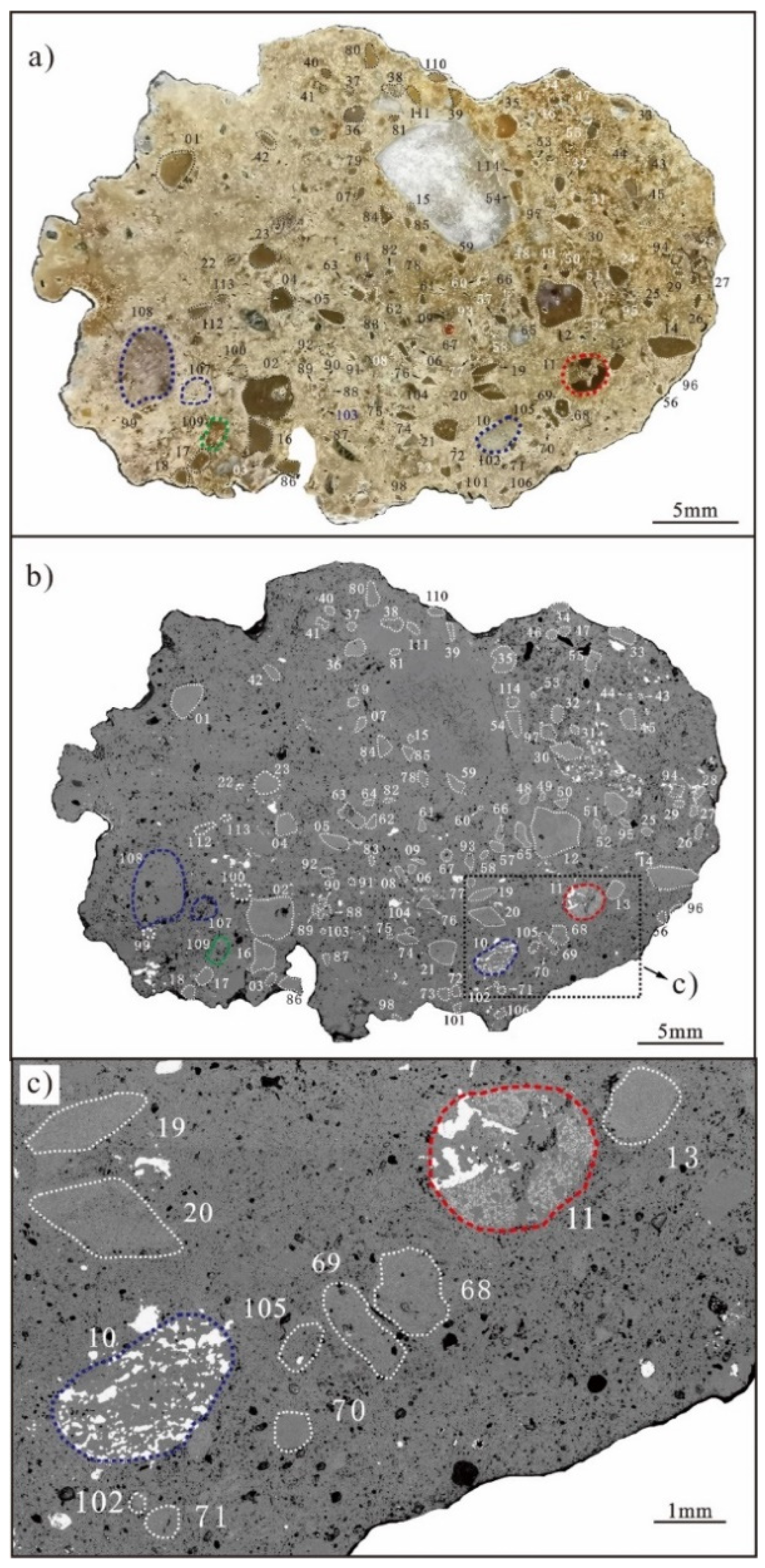
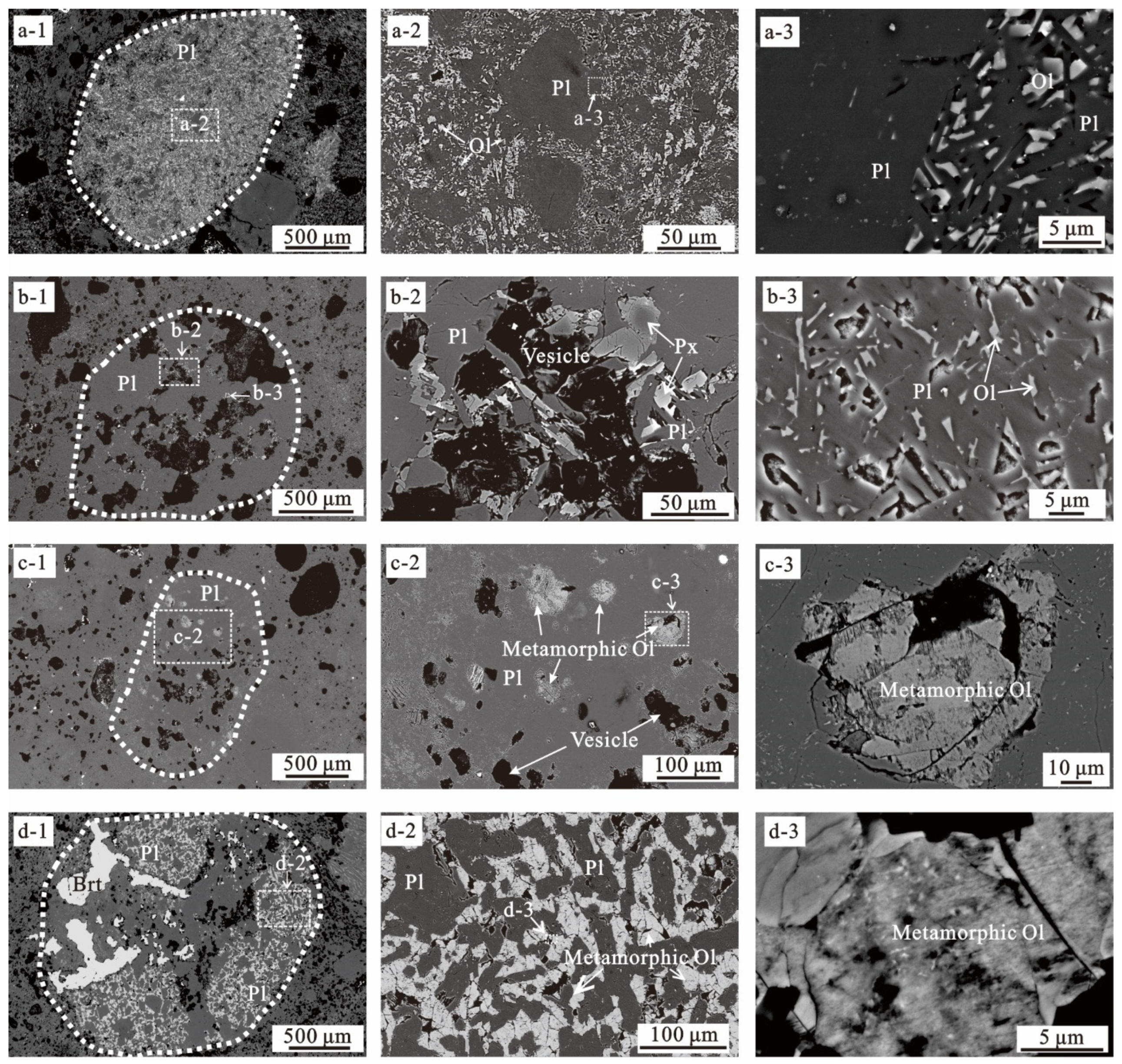
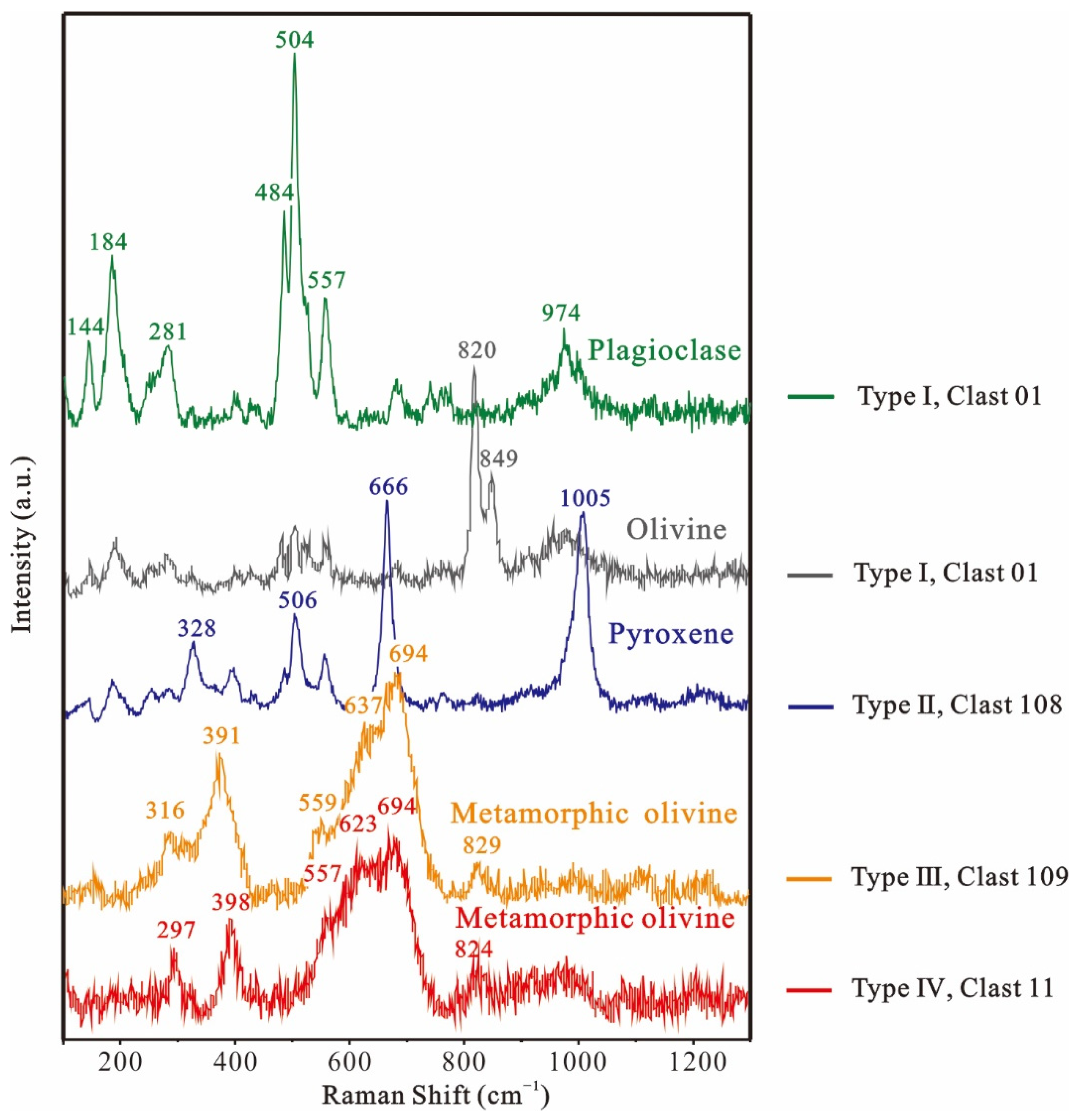

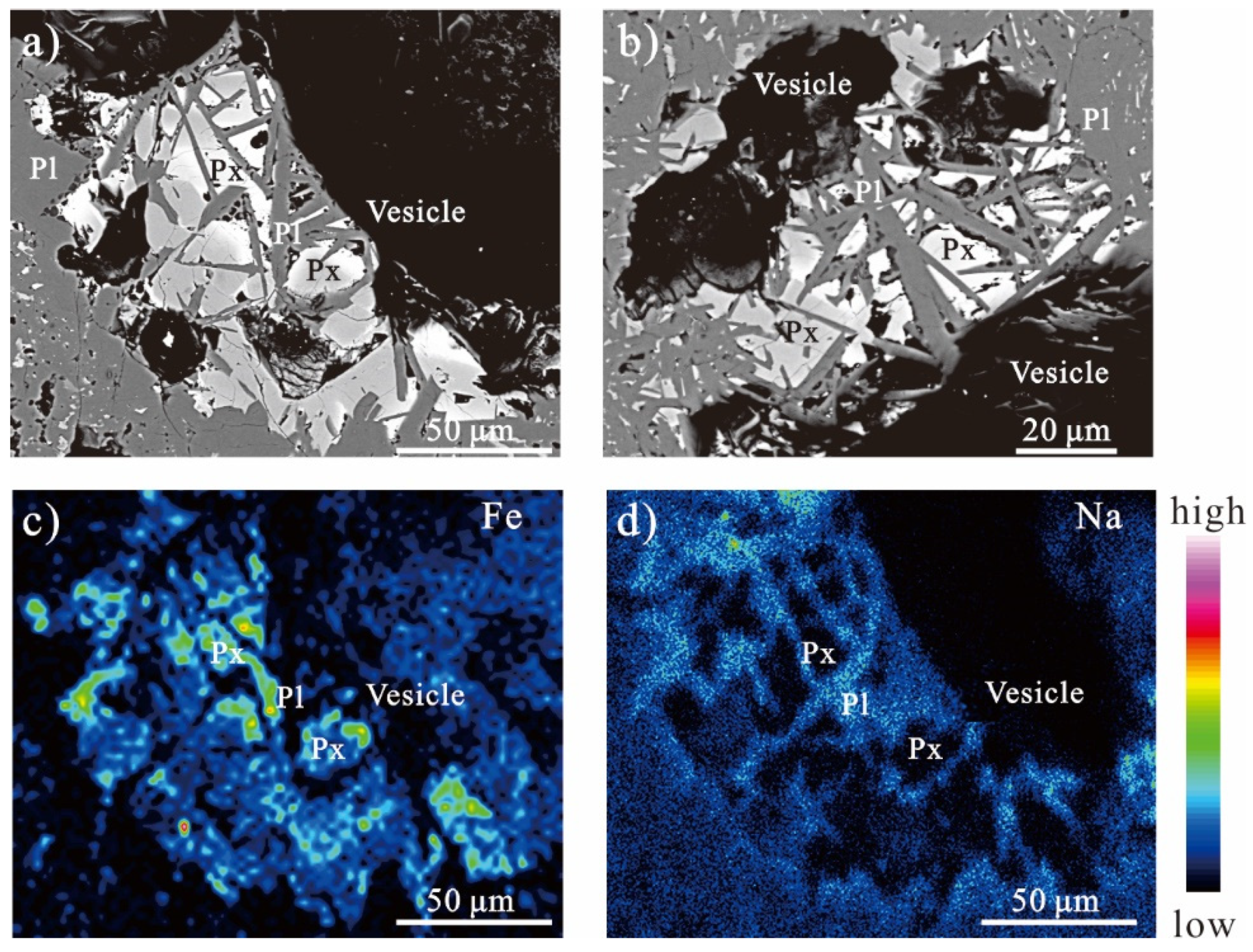

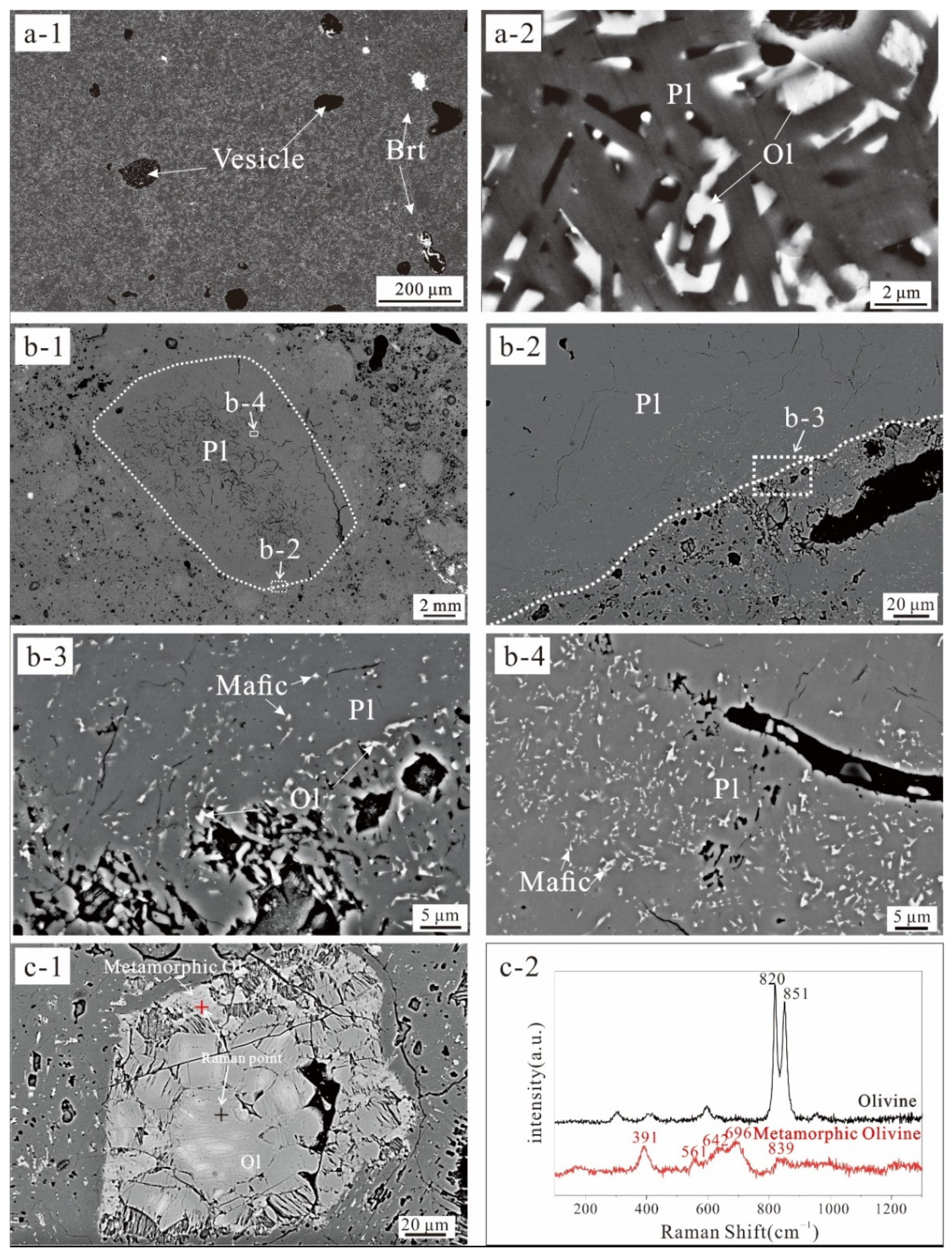
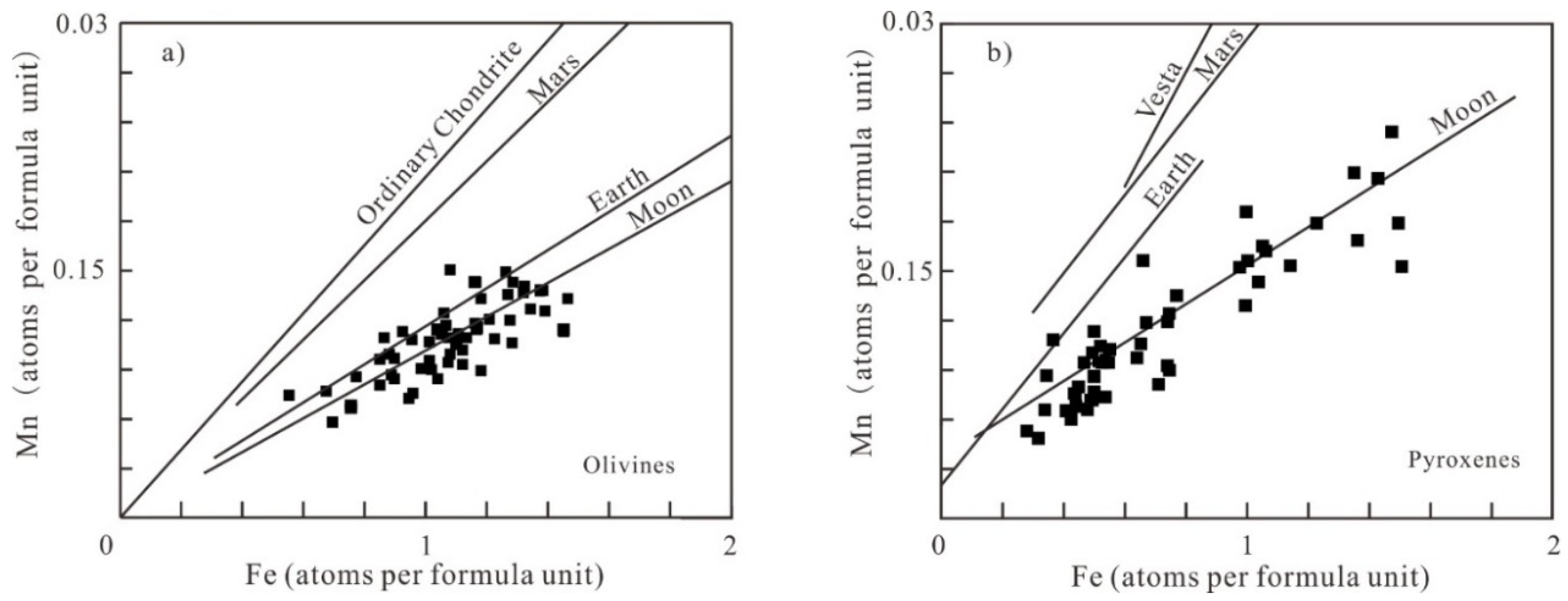

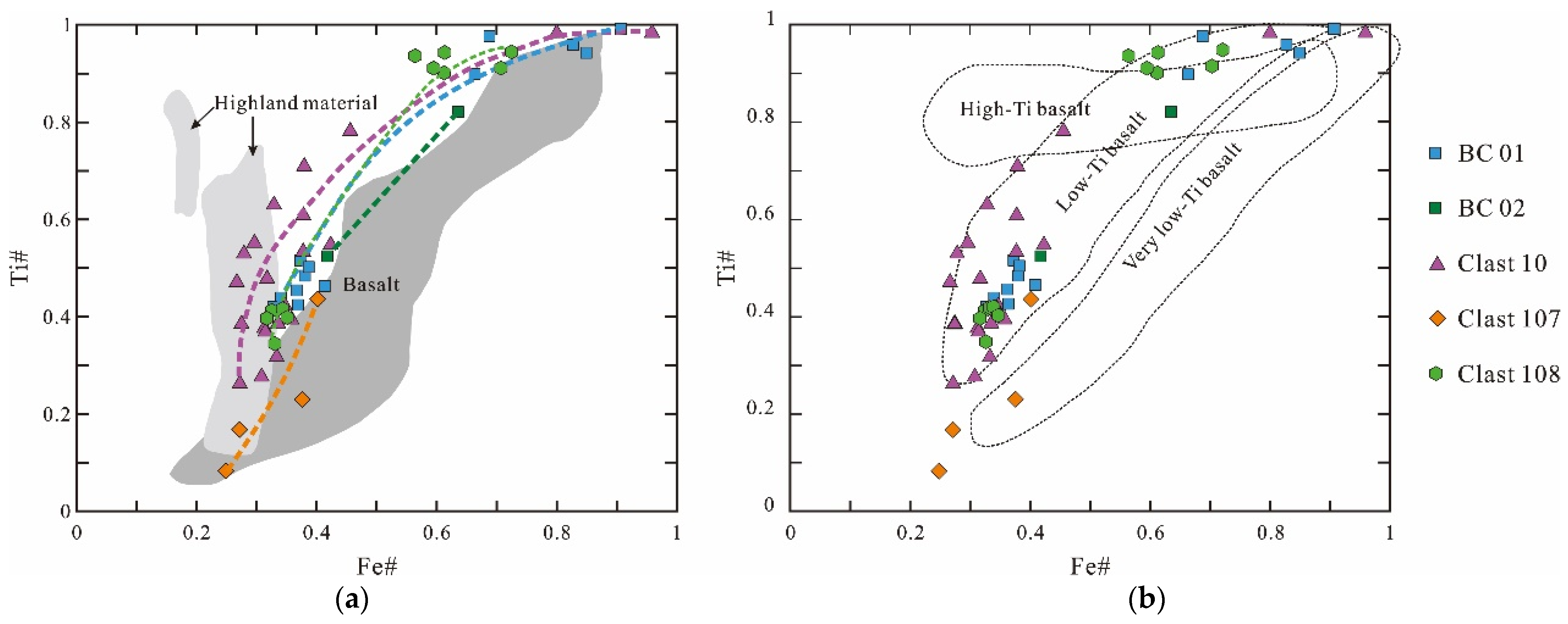
| Clast | 1 | 2 | 4 | 5 | 6 | 7 | ||||||||
|---|---|---|---|---|---|---|---|---|---|---|---|---|---|---|
| Ol | Pl | Ol | Pl | Ol | Pl | Ol | Pl | Chr | Ol | Pl | Ol | Pl | ||
| n | 4 | 3 | 3 | 3 | 7 | 4 | 4 | 5 | 1 | 4 | 5 | 4 | 3 | |
| SiO2 | 38.81 | 44.07 | 38.72 | 44.3 | 37.2 | 42.91 | 37.72 | 44.34 | 0.59 | 38.32 | 42.47 | 37.43 | 42.28 | |
| TiO2 | b.d. | 0.03 | 0.03 | 0.05 | 0.09 | 0.15 | 0.05 | 0.16 | 1.61 | 0.03 | 0.36 | 0.05 | 0.07 | |
| Al2O3 | 0.07 | 34.82 | 0.54 | 35.32 | 1.02 | 34.38 | 1.02 | 32.03 | 16.02 | 1.14 | 35.88 | 0.26 | 35.38 | |
| Cr2O3 | 0.25 | b.d. | 0.24 | 0.05 | 0.26 | 0.01 | 0.3 | 0.06 | 47.2 | 0.3 | b.d. | 0.2 | b.d. | |
| FeO | 20.22 | 0.55 | 21.79 | 0.51 | 26.52 | 0.81 | 23.46 | 2.09 | 27.17 | 19.79 | 0.43 | 25.32 | 0.37 | |
| MnO | 0.25 | 0.02 | 0.27 | 0.06 | 0.31 | 0.01 | 0.29 | 0.05 | 0.32 | 0.28 | 0.01 | 0.32 | 0.02 | |
| MgO | 39.04 | 0.21 | 37.22 | 0.24 | 32.96 | 0.36 | 34.82 | 1.22 | 5.04 | 38.34 | 0.16 | 34.41 | 0.19 | |
| CaO | 0.44 | 19.92 | 0.62 | 19.18 | 0.95 | 19.68 | 0.99 | 19.19 | 0.73 | 1.07 | 20.21 | 0.54 | 19.72 | |
| Na2O | 0.01 | 0.31 | 0.01 | 0.33 | 0.02 | 0.42 | 0.01 | 0.48 | b.d. | b.d. | 0.46 | 0.01 | 0.5 | |
| K2O | b.d. | 0.01 | 0.01 | b.d. | 0.01 | 0.03 | 0.02 | 0.02 | b.d. | b.d. | b.d. | b.d. | 0.01 | |
| P2O5 | b.d. | b.d. | 0.01 | 0.04 | 0.03 | 0.01 | 0.02 | 0.02 | 0.01 | 0.04 | 0.01 | 0.01 | 0.01 | |
| Total | 99.09 | 99.94 | 99.46 | 100.08 | 99.37 | 98.77 | 98.7 | 99.66 | 98.69 | 99.31 | 99.99 | 98.55 | 98.55 | |
| Oxygen Cations | 4 | 8 | 4 | 8 | 4 | 8 | 4 | 8 | 4 | 4 | 8 | 4 | 8 | |
| Si | 1.009 | 2.048 | 1.010 | 2.049 | 0.996 | 2.024 | 1.002 | 2.083 | 0.020 | 0.994 | 1.979 | 1.005 | 1.996 | |
| Ti | - | 0.001 | 0.001 | 0.002 | 0.002 | 0.005 | 0.001 | 0.006 | 0.041 | 0.001 | 0.013 | 0.001 | 0.002 | |
| Al | 0.002 | 1.907 | 0.017 | 1.925 | 0.032 | 1.911 | 0.032 | 1.773 | 0.634 | 0.035 | 1.971 | 0.008 | 1.968 | |
| Cr | 0.005 | - | 0.005 | 0.002 | 0.006 | 0.000 | 0.006 | 0.002 | 1.252 | 0.006 | 0.000 | 0.004 | 0.000 | |
| Fe | 0.440 | 0.021 | 0.475 | 0.020 | 0.594 | 0.032 | 0.521 | 0.082 | 0.762 | 0.429 | 0.017 | 0.569 | 0.015 | |
| Mn | 0.006 | 0.001 | 0.006 | 0.002 | 0.007 | 0.000 | 0.007 | 0.002 | 0.009 | 0.006 | 0.000 | 0.007 | 0.001 | |
| Mg | 1.513 | 0.015 | 1.447 | 0.017 | 1.316 | 0.025 | 1.379 | 0.085 | 0.252 | 1.482 | 0.011 | 1.377 | 0.013 | |
| Ca | 0.012 | 0.992 | 0.017 | 0.951 | 0.027 | 0.995 | 0.028 | 0.966 | 0.026 | 0.030 | 1.009 | 0.016 | 0.997 | |
| Na | 0.001 | 0.028 | 0.001 | 0.030 | 0.001 | 0.038 | 0.001 | 0.044 | - | - | 0.042 | 0.001 | 0.046 | |
| K | - | 0.001 | 0.000 | - | 0.000 | 0.002 | 0.001 | 0.001 | - | - | - | - | 0.001 | |
| P | - | - | 0.000 | 0.002 | 0.001 | 0.000 | 0.000 | 0.001 | 0.000 | 0.001 | 0.000 | 0.000 | 0.000 | |
| Total | 2.99 | 5.01 | 2.98 | 5.00 | 2.98 | 5.03 | 2.98 | 5.04 | 3.00 | 2.98 | 5.04 | 2.99 | 5.04 | |
| Fe/Mn | 79.1 | 78.6 | 85.6 | 83.1 | 70.1 | 79.8 | ||||||||
| (70.1–92.5) | (67.5–99.2) | (72.7–107.3) | (64.0–101.2) | (65.4–84.1) | (72.8–91.1) | |||||||||
| Fo | 77.5 | 75.3 | 68.9 | 72.5 | 77.5 | 70.8 | ||||||||
| (74.4–80.1) | (74.3–76.0) | (64.0–76.9) | (71.5–73.8) | (76.4–79.0) | (69.7–73.0) | |||||||||
| An | 97.2 | 97 | 96.1 | 95.6 | 96 | 95.6 | ||||||||
| (97.0–97.4) | (96.8–97.3) | (94.8–97.2) | (94.5–96.4) | (95.8–96.3) | (95.5–95.7) | |||||||||
| Ab | 2.8 | 3 | 3.7 | 4.3 | 3.9 | 4.4 | ||||||||
| (2.6–3.0) | (2.7–3.2) | (2.7–4.5) | (3.5–5.3) | (3.6–4.2) | (4.3–4.4) | |||||||||
| Clast | 12 | 13 | 15 | 16 | 17 | 39 | ||||||||
| Ol | Pl | Ol | Pl | Ol | Pl | Ol | Pl | Ol | Pl | Ol | Pl | |||
| n | 3 | 6 | 9 | 5 | 5 | 4 | 3 | 3 | 5 | 3 | 4 | 3 | ||
| SiO2 | 37.71 | 42.18 | 36.88 | 42.12 | 37.31 | 44.39 | 37.01 | 44.03 | 39.04 | 44.68 | 37.59 | 44.91 | ||
| TiO2 | 0.12 | 0.18 | 0.17 | 0.02 | 0.07 | 0.01 | 0.07 | 0.14 | 0.02 | 0.01 | 0.04 | 0.05 | ||
| Al2O3 | 1.12 | 35.62 | 0.17 | 35.11 | 0.82 | 35.09 | 1.89 | 35.19 | 0.07 | 35.49 | 0.19 | 35.49 | ||
| Cr2O3 | 0.08 | b.d. | 0.3 | 0.01 | 0.24 | 0.01 | 0.13 | b.d. | 0.23 | 0.01 | 0.20 | b.d. | ||
| FeO | 25.5 | 0.25 | 23.3 | 0.59 | 26.21 | 0.42 | 26.69 | 0.32 | 17.78 | 0.37 | 25.63 | 0.28 | ||
| MnO | 0.25 | 0.02 | 0.27 | 0.01 | 0.27 | 0.02 | 0.30 | 0.03 | 0.19 | b.d. | 0.25 | b.d. | ||
| MgO | 33.61 | 0.14 | 37.01 | 0.34 | 32.62 | 0.2 | 31.28 | 0.21 | 41.69 | 0.16 | 34.69 | 0.17 | ||
| CaO | 0.93 | 19.4 | 0.6 | 19.61 | 0.77 | 19.93 | 1.51 | 20.41 | 0.36 | 19.81 | 0.53 | 19.08 | ||
| Na2O | 0.03 | 0.82 | 0.05 | 0.51 | 0.02 | 0.42 | 0.02 | 0.38 | 0.01 | 0.46 | 0.01 | 0.48 | ||
| K2O | 0.01 | 0.02 | 0.02 | 0.02 | 0.01 | 0.02 | b.d. | 0.01 | 0.01 | 0.01 | 0.01 | 0.01 | ||
| P2O5 | 0.03 | 0.01 | 0.01 | 0.01 | 0.01 | 0.02 | b.d. | 0.01 | 0.02 | 0.02 | 0.03 | b.d. | ||
| Total | 99.39 | 98.64 | 98.78 | 98.35 | 98.35 | 100.53 | 98.9 | 100.73 | 99.42 | 101.02 | 99.17 | 100.47 | ||
| Oxygen Cations | 4 | 8 | 4 | 8 | 4 | 8 | 4 | 8 | 4 | 8 | 4 | 8 | ||
| Si | 1.003 | 1.989 | 0.982 | 1.995 | 1.008 | 2.049 | 0.997 | 2.032 | 1.000 | 2.050 | 1.004 | 2.064 | ||
| Ti | 0.002 | 0.006 | 0.003 | 0.001 | 0.001 | 0.000 | 0.001 | 0.005 | 0.000 | 0.000 | 0.001 | 0.002 | ||
| Al | 0.035 | 1.980 | 0.005 | 1.960 | 0.026 | 1.909 | 0.060 | 1.914 | 0.002 | 1.919 | 0.006 | 1.923 | ||
| Cr | 0.002 | - | 0.006 | 0.000 | 0.005 | 0.000 | 0.003 | - | 0.005 | 0.000 | 0.004 | - | ||
| Fe | 0.567 | 0.010 | 0.519 | 0.023 | 0.592 | 0.016 | 0.601 | 0.012 | 0.381 | 0.014 | 0.572 | 0.011 | ||
| Mn | 0.006 | 0.001 | 0.006 | 0.000 | 0.006 | 0.001 | 0.007 | 0.001 | 0.004 | - | 0.006 | - | ||
| Mg | 1.332 | 0.010 | 1.468 | 0.024 | 1.313 | 0.014 | 1.256 | 0.014 | 1.592 | 0.011 | 1.381 | 0.012 | ||
| Ca | 0.026 | 0.980 | 0.017 | 0.995 | 0.022 | 0.986 | 0.044 | 1.009 | 0.010 | 0.974 | 0.015 | 0.940 | ||
| Na | 0.002 | 0.075 | 0.003 | 0.047 | 0.001 | 0.038 | 0.001 | 0.034 | 0.000 | 0.041 | 0.001 | 0.043 | ||
| K | 0.000 | 0.001 | 0.001 | 0.001 | 0.000 | 0.001 | - | 0.001 | 0.000 | 0.001 | 0.000 | 0.001 | ||
| P | 0.001 | 0.000 | 0.000 | 0.000 | 0.000 | 0.001 | - | 0.000 | 0.000 | 0.001 | 0.001 | - | ||
| Total | 2.98 | 5.05 | 3.01 | 5.04 | 2.98 | 5.01 | 2.97 | 5.02 | 3.00 | 5.01 | 2.99 | 4.99 | ||
| Fe/Mn | 99.8 | 85.5 | 98.1 | 89.5 | 92.8 | 103.4 | ||||||||
| (97.6–101.1) | (73.3–95.5) | (87.6–117.6) | (84.5–96.7) | (78.6–105.6) | (84.4–112.5) | |||||||||
| Fo | 70.1 | 73.9 | 68.9 | 67.6 | 80.7 | 70.7 | ||||||||
| (67.5–72.7) | (70.1–77.2) | (65.9–70.7) | (65.4–71.0) | (78.5–82.5) | (65.5–75.5) | |||||||||
| An | 92.8 | 95.4 | 96.2 | 96.6 | 95.9 | 95.6 | ||||||||
| (90.9–94.7) | (95.1–95.8) | (95.9–96.5) | (96.1–97.1) | (95.6–96.0) | (95.1–96.1) | |||||||||
| Ab | 7.1 | 4.5 | 3.7 | 3.3 | 4 | 4.4 | ||||||||
| (5.2–8.9) | (4.0–4.8) | (3.5–4.0) | (3.1–3.7) | (3.9–4.3) | (4.1–4.6) | |||||||||
| Type | Type 2 | Type 3 | Type 4 | ||||||||||||||||
|---|---|---|---|---|---|---|---|---|---|---|---|---|---|---|---|---|---|---|---|
| Clast | 10 | 107 | 108 | 109 | 11 | ||||||||||||||
| Ol | Pl | Basaltic | Basaltic | Chr | Ol | Pl | Basaltic | Basaltic | Ol | Pl | Basaltic | Basaltic | Metamorphic | Ol | Pl | Metamorphic | Ol | Pl | |
| Pl | Px | Pl | Px | Pl | Px | Ol | Ol | ||||||||||||
| n | 3 | 14 | 1 | 24 | 2 | 1 | 1 | 4 | 4 | 1 | 9 | 1 | 13 | 1 | 1 | 1 | 5 | 1 | 4 |
| SiO2 | 38.43 | 43.82 | 45.51 | 49.6 | 0.03 | 39.88 | 44.57 | 48.49 | 52.21 | 37.21 | 45.5 | 49.13 | 49.73 | 37.96 | 36.23 | 43.91 | 35.41 | 37.92 | 42.88 |
| TiO2 | 0.02 | 0.08 | 0.02 | 0.6 | 5.08 | b.d. | 0.03 | 0.03 | 0.34 | 0.12 | 0.04 | 0.09 | 0.97 | 0.08 | b.d. | 0.02 | 0.16 | 0.04 | 0.15 |
| Al2O3 | 0.32 | 35.12 | 33.81 | 4.56 | 10.78 | 0.10 | 34.63 | 32.72 | 2.96 | 0.09 | 33.03 | 28.51 | 2.89 | 0.33 | 1.90 | 35.56 | 0.31 | 0.15 | 34.38 |
| Cr2O3 | 0.19 | 0.01 | 0.01 | 0.56 | 45.42 | 0.18 | 0.01 | 0.01 | 1.1 | 0.22 | 0.02 | 0.06 | 0.75 | 0.13 | 0.25 | b.d. | 0.22 | 0.28 | 0.01 |
| FeO | 23.79 | 0.57 | 0.51 | 13.73 | 34.33 | 13.28 | 0.31 | 0.48 | 14.31 | 29.32 | 0.38 | 1.19 | 19.08 | 21.66 | 30.38 | 0.25 | 31.69 | 25.21 | 0.83 |
| NiO | b.d. | 0.01 | 0.01 | 0.01 | 0.02 | b.d. | 0.01 | 0.01 | 0.03 | 0.02 | 0.01 | b.d. | b.d. | b.d. | b.d. | 0.03 | 0.02 | b.d. | 0.02 |
| MnO | 0.25 | 0.02 | 0.01 | 0.23 | 0.29 | 0.2 | b.d. | b.d. | 0.27 | 0.34 | b.d. | 0.02 | 0.33 | 0.19 | 0.34 | b.d. | 0.3 | 0.23 | 0.01 |
| MgO | 35.61 | 0.2 | 0.31 | 14.24 | 2.37 | 46.27 | 0.21 | 0.43 | 21.68 | 32.72 | 0.21 | 0.8 | 13.41 | 39.16 | 30.34 | 0.15 | 30.37 | 35.22 | 0.36 |
| CaO | 0.63 | 19.48 | 18.29 | 15.38 | 0.04 | 0.28 | 19.42 | 17.19 | 6.76 | 0.41 | 19.18 | 17.18 | 12.03 | 0.49 | 1.43 | 19.52 | 0.51 | 0.47 | 19.68 |
| Na2O | 0.02 | 0.41 | 1.15 | 0.05 | 0.04 | 0.02 | 0.33 | 1.34 | 0.04 | b.d. | 0.57 | 1.36 | 0.05 | 0.02 | b.d. | 0.35 | 0.02 | 0.02 | 0.42 |
| K2O | 0.02 | 0.02 | 0.02 | 0.01 | b.d. | 0.01 | 0.01 | 0.01 | b.d. | b.d. | 0.01 | 0.03 | b.d. | 0.01 | 0.01 | 0.01 | 0.03 | 0.01 | 0.03 |
| P2O5 | 0.01 | 0.01 | 0.01 | 0.02 | 0.01 | b.d. | b.d. | b.d. | b.d. | 0.01 | 0.05 | b.d. | 0.02 | 0.03 | 0.02 | b.d. | 0.01 | 0.07 | 0.01 |
| Total | 99.29 | 99.75 | 99.66 | 98.99 | 98.41 | 100.22 | 99.53 | 100.71 | 99.7 | 100.46 | 99 | 98.37 | 99.26 | 100.06 | 100.9 | 99.8 | 99.05 | 99.62 | 98.78 |
| Oxygen Cations | 4 | 8 | 8 | 6 | 4 | 4 | 8 | 8 | 6 | 4 | 8 | 8 | 6 | 4 | 4 | 8 | 4 | 4 | 8 |
| Si | 1.014 | 2.039 | 2.111 | 1.880 | 0.001 | 0.992 | 2.071 | 2.208 | 1.918 | 0.998 | 2.125 | 2.301 | 1.911 | 0.986 | 0.975 | 2.037 | 0.980 | 1.005 | 2.023 |
| Ti | 0.000 | 0.003 | 0.001 | 0.017 | 0.135 | - | 0.001 | 0.001 | 0.009 | 0.002 | 0.001 | 0.003 | 0.028 | 0.002 | - | 0.001 | 0.003 | 0.001 | 0.005 |
| Al | 0.010 | 1.926 | 1.848 | 0.204 | 0.449 | 0.003 | 1.897 | 1.756 | 0.128 | 0.003 | 1.818 | 1.574 | 0.131 | 0.010 | 0.060 | 1.944 | 0.010 | 0.005 | 1.912 |
| Cr | 0.004 | 0.000 | 0.000 | 0.017 | 1.269 | 0.004 | 0.000 | 0.000 | 0.032 | 0.005 | 0.001 | 0.002 | 0.023 | 0.003 | 0.005 | - | 0.005 | 0.006 | 0.000 |
| Fe | 0.525 | 0.022 | 0.020 | 0.435 | 1.014 | 0.276 | 0.012 | 0.018 | 0.440 | 0.658 | 0.015 | 0.047 | 0.613 | 0.470 | 0.684 | 0.010 | 0.734 | 0.559 | 0.033 |
| Ni | - | 0.000 | 0.000 | 0.000 | 0.001 | - | 0.000 | 0.000 | 0.001 | 0.000 | 0.000 | - | - | - | - | 0.001 | 0.000 | - | 0.001 |
| Mn | 0.006 | 0.001 | 0.000 | 0.007 | 0.009 | 0.004 | - | - | 0.008 | 0.008 | - | 0.001 | 0.011 | 0.004 | 0.008 | - | 0.007 | 0.005 | 0.000 |
| Mg | 1.401 | 0.014 | 0.021 | 0.805 | 0.125 | 1.717 | 0.015 | 0.029 | 1.188 | 1.309 | 0.015 | 0.056 | 0.768 | 1.516 | 1.217 | 0.010 | 1.253 | 1.391 | 0.025 |
| Ca | 0.018 | 0.971 | 0.909 | 0.625 | 0.002 | 0.007 | 0.967 | 0.839 | 0.266 | 0.012 | 0.960 | 0.862 | 0.495 | 0.014 | 0.041 | 0.970 | 0.015 | 0.013 | 0.995 |
| Na | 0.001 | 0.037 | 0.103 | 0.004 | 0.003 | 0.001 | 0.030 | 0.118 | 0.003 | - | 0.052 | 0.123 | 0.004 | 0.001 | - | 0.031 | 0.001 | 0.001 | 0.038 |
| K | 0.001 | 0.001 | 0.001 | 0.000 | - | 0.000 | 0.001 | 0.001 | - | - | 0.001 | 0.002 | - | 0.000 | 0.000 | 0.001 | 0.001 | 0.000 | 0.002 |
| P | 0.000 | 0.000 | 0.000 | 0.001 | 0.000 | - | - | - | - | 0.000 | 0.002 | - | 0.001 | 0.001 | 0.000 | - | 0.000 | 0.002 | 0.000 |
| Total | 2.98 | 5.01 | 5.02 | 3.99 | 3.01 | 3.00 | 4.99 | 4.97 | 3.99 | 3.00 | 4.99 | 4.97 | 3.98 | 3.01 | 2.99 | 5.01 | 3.01 | 2.99 | 5.04 |
| Fe/Mn | 92.8 | 56.9 | 66.5 | 53.5 | 86.3 | 56.6 | 115.7 | 88.6 | 101.9 | 107.3 | |||||||||
| (87.4–96.9) | (38.1–111.4) | (40.0–65.6) | (34.3–84.2) | (89.6–113.8) | |||||||||||||||
| Fo | 72.7 | 86.1 | 66.6 | 76.3 | 64 | 64.8 | 71.3 | ||||||||||||
| (72.0–73.8) | (66.2–67.8) | ||||||||||||||||||
| Mg# | 65.8 | 72.2 | 56.2 | ||||||||||||||||
| (5.2–74.0) | (64.6–76.8) | (29.7–72.5) | |||||||||||||||||
| An | 96.3 | 89.7 | 97 | 87.6 | 94.8 | 87.4 | 96.8 | 96.3 | |||||||||||
| (94.6–97.7) | (86.4–88.8) | (92.0–96.6) | (95.2–97.7) | ||||||||||||||||
| Ab | 3.65 | 10.2 | 3 | 12.4 | 5.13 | 12.5 | 3.17 | 3.6 | |||||||||||
| (2.19–5.65) | (11.2–13.5) | (3.31–8.0) | (2.3–4.7) | ||||||||||||||||
| Fs | 23.7 | 23.3 | 32.8 | ||||||||||||||||
| (14.6–74.7) | (19.0–27.4) | (17.8–50.7) | |||||||||||||||||
| En | 42.9 | 62.4 | 40.7 | ||||||||||||||||
| (4.08–56.1) | (50.0–75.0) | (19.8–59.7) | |||||||||||||||||
| Wo | 33.4 | 14.2 | 26.5 | ||||||||||||||||
| (15.4–41.9) | (5.9–22.6) | (14.4–40.6) | |||||||||||||||||
| BC 01 | BC 02 | |||
|---|---|---|---|---|
| Px | Pl | Px | Pl | |
| n | 14 | 3 | 2 | 2 |
| SiO2 | 50.02 | 47.86 | 49.39 | 47.48 |
| TiO2 | 1.01 | 0.07 | 0.5 | 0.02 |
| Al2O3 | 3.27 | 32.01 | 2.31 | 31.67 |
| Cr2O3 | 0.64 | 0.01 | 0.24 | 0.01 |
| FeO | 19.01 | 1.3 | 21.4 | 1.13 |
| NiO | 0.02 | 0.01 | 0.02 | 0.03 |
| MnO | 0.32 | 0.03 | 0.33 | 0.03 |
| MgO | 10.72 | 0.45 | 12.59 | 0.52 |
| CaO | 15.88 | 18.67 | 11.61 | 17.29 |
| Na2O | 0.04 | 0.87 | 0.02 | 0.95 |
| K2O | 0.01 | 0.05 | b.d. | 0.03 |
| P2O5 | 0.03 | 0.02 | 0.02 | 0.03 |
| Total | 100.97 | 101.35 | 98.43 | 99.19 |
| Oxygen Cations | 6 | 8 | 6 | 8 |
| Si | 1.907 | 2.186 | 1.932 | 2.205 |
| Ti | 0.029 | 0.002 | 0.015 | 0.001 |
| Al | 0.147 | 1.723 | 0.107 | 1.733 |
| Cr | 0.019 | 0.000 | 0.007 | 0.000 |
| Fe | 0.606 | 0.050 | 0.700 | 0.044 |
| Ni | 0.001 | 0.000 | 0.001 | 0.001 |
| Mn | 0.010 | 0.001 | 0.011 | 0.001 |
| Mg | 0.609 | 0.031 | 0.734 | 0.036 |
| Ca | 0.649 | 0.914 | 0.487 | 0.860 |
| Na | 0.003 | 0.077 | 0.002 | 0.086 |
| K | 0.000 | 0.003 | - | 0.002 |
| P | 0.001 | 0.001 | 0.001 | 0.001 |
| Total | 3.98 | 4.99 | 4.00 | 4.97 |
| Fe/Mn | 55.5 | 65.0 | ||
| (37.3–72.9) | (50.3–79.8) | |||
| Mg# | 51.8 | 51.0 | ||
| (9.76–71.9) | (39.0–63.0) | |||
| Fs | 33.0 | 36.6 | ||
| (15.1–69.7) | (27.8–45.3) | |||
| En | 32.3 | 38.1 | ||
| (7.5–44.2) | (29.0–47.2) | |||
| Wo | 34.7 | 25.3 | ||
| (22.4–46.1) | (25.0–25.7) | |||
| An | 91.9 | 90.8 | ||
| (90.3–94.6) | (89.5–92.1) | |||
| Ab | 7.83 | 9.02 | ||
| (5.12–9.53) | (7.81–10.2) | |||
| First Type of Crystalline Impact Melt Clasts | Matrix | NWA 13120 | ||||||
|---|---|---|---|---|---|---|---|---|
| Clast 01 | Clast 02 | Clast 04 | Clast 16 | |||||
| EPMA-Defocus | EPMA-Molten Bead | |||||||
| n | 11 | 7 | 5 | 5 | 11 | 34 | Normalization | 10 |
| SiO2 | 42.9 ± 2.32 | 43.0 ± 1.7 | 42.6 ± 0.61 | 42.5 ± 2.4 | 43.1 ± 3.6 | 41.3 ± 3.8 | 43.7 | 44.1 ± 0.72 |
| TiO2 | 0.24 ± 0.03 | 0.24 ± 0.04 | 0.24 ± 0.00 | 0.23 ± 0.04 | 0.26 ± 0.05 | 0.27 ± 0.08 | 0.29 | 0.27 ± 0.05 |
| Al2O3 | 28.9 ± 1.6 | 28.7 ± 0.81 | 29.4 ± 0.32 | 28.4 ± 1.71 | 31.4 ± 3.24 | 30.1 ± 5.52 | 31.9 | 30.7 ± 1.03 |
| Cr2O3 | 0.06 ± 0.01 | 0.09 ± 0.01 | 0.11 ± 0.00 | 0.06 ± 0.01 | 0.07 ± 0.03 | 0.07 ± 0.03 | 0.07 | 0.06 ± 0.01 |
| FeO | 3.68 ± 0.40 | 4.47 ± 0.21 | 3.87 ± 0.13 | 4.46 ± 0.51 | 2.34 ± 0.80 | 2.13 ± 0.70 | 2.25 | 2.74 ± 0.48 |
| MnO | 0.05 ± 0.01 | 0.06 ± 0.01 | 0.05 ± 0.00 | 0.05 ± 0.01 | 0.03 ± 0.02 | 0.03 ± 0.01 | 0.03 | 0.04 ± 0.01 |
| MgO | 3.15 ± 0.20 | 3.94 ± 0.10 | 2.67 ± 0.03 | 4.30 ± 0.30 | 1.91 ± 0.30 | 1.75 ± 0.30 | 1.85 | 1.85 ± 0.31 |
| CaO | 16.8 ± 0.90 | 16.4 ± 0.60 | 17.1 ± 0.20 | 16.1 ± 1.10 | 18.9 ± 1.10 | 18.3 ± 1.40 | 19.4 | 18.9 ± 0.48 |
| Na2O | 0.39 ± 0.04 | 0.42 ± 0.04 | 0.35 ± 0.02 | 0.56 ± 0.08 | 0.41 ± 0.10 | 0.49 ± 0.10 | 0.52 | 0.51 ± 0.05 |
| K2O | 0.03 ± 0.00 | 0.04 ± 0.00 | 0.03 ± 0.00 | 0.04 ± 0.01 | 0.04 ± 0.02 | 0.04 ± 0.02 | 0.04 | 0.16 ± 0.03 |
| P2O5 | 0.01 ± 0.00 | 0.02 ± 0.00 | 0.02 ± 0.00 | 0.03 ± 0.00 | 0.01 ± 0.00 | 0.02 ± 0.01 | 0.02 | 0.02 ± 0.01 |
| Total | 96.2 | 97.4 | 96.5 | 96.7 | 98.5 | 94.5 | 100 | 99.4 |
| Mg# | 60.4 | 61.1 | 55.2 | 63.2 | 59.3 | 59.4 | 54.6 | |
| Fe/Mn | 72.7 | 73.6 | 76.4 | 80.1 | 77 | 74.1 | 67.6 | |
| (MgO + FeO)/Al2O3 | 0.24 | 0.29 | 0.22 | 0.31 | 0.14 | 0.13 | 0.15 | |
Publisher’s Note: MDPI stays neutral with regard to jurisdictional claims in published maps and institutional affiliations. |
© 2021 by the authors. Licensee MDPI, Basel, Switzerland. This article is an open access article distributed under the terms and conditions of the Creative Commons Attribution (CC BY) license (https://creativecommons.org/licenses/by/4.0/).
Share and Cite
Xia, Z.; Miao, B.; Zhang, C.; Chen, H.; Xie, L.; Ranjith, P.M.; Zhang, Y.; Si, B. Petrography and Shock Metamorphism of the Lunar Breccia Meteorite NWA 13120. Minerals 2021, 11, 899. https://doi.org/10.3390/min11080899
Xia Z, Miao B, Zhang C, Chen H, Xie L, Ranjith PM, Zhang Y, Si B. Petrography and Shock Metamorphism of the Lunar Breccia Meteorite NWA 13120. Minerals. 2021; 11(8):899. https://doi.org/10.3390/min11080899
Chicago/Turabian StyleXia, Zhipeng, Bingkui Miao, Chuantong Zhang, Hongyi Chen, Lanfang Xie, P. M. Ranjith, Yikai Zhang, and Bowen Si. 2021. "Petrography and Shock Metamorphism of the Lunar Breccia Meteorite NWA 13120" Minerals 11, no. 8: 899. https://doi.org/10.3390/min11080899
APA StyleXia, Z., Miao, B., Zhang, C., Chen, H., Xie, L., Ranjith, P. M., Zhang, Y., & Si, B. (2021). Petrography and Shock Metamorphism of the Lunar Breccia Meteorite NWA 13120. Minerals, 11(8), 899. https://doi.org/10.3390/min11080899






